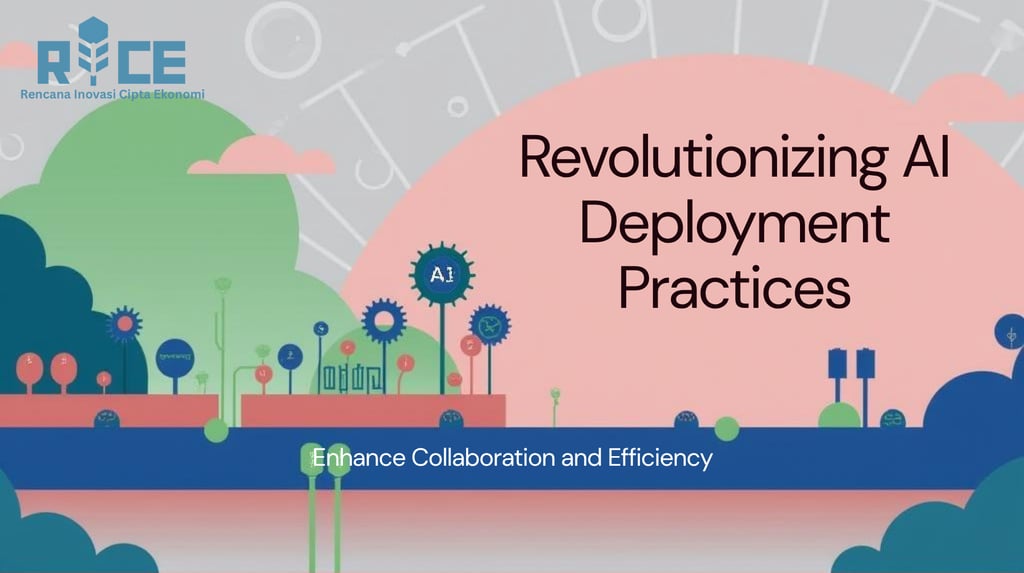Revolutionizing AI Deployment: Implementing DevOps Best Practices in the Model Lifecycle
Streamline AI deployment with CI/CD pipelines. Learn automation, monitoring, and DevOps best practices to move models from lab to production
TECHNOLOGY
Rice AI (Ratna)
7/15/20256 min read


Introduction: The AI Deployment Challenge
In today's competitive landscape, organizations race to transform machine learning prototypes into production-grade assets. Yet nearly 87% of AI projects never make it to deployment. The disconnect between experimental AI and operational AI represents one of the most significant bottlenecks in enterprise AI adoption. Traditional software development solved this challenge through DevOps methodologies, particularly Continuous Integration and Continuous Deployment (CI/CD). When adapted intelligently for machine learning, these practices form the backbone of a robust AI delivery system that accelerates deployment while maintaining quality and reliability.
CI/CD for AI represents more than just technical automation; it signifies a fundamental shift in how data scientists, developers, and operations teams collaborate. By implementing specialized CI/CD pipelines for machine learning, organizations can navigate the unique complexities of the AI lifecycle—from data versioning and model reproducibility to performance monitoring and ethical compliance. This article examines how DevOps best practices transform AI deployment from a bottleneck into a strategic advantage, drawing on industry frameworks and real-world implementations.
Section 1: The AI/ML Lifecycle and CI/CD Integration
1.1 Distinct Challenges in AI Development
AI systems introduce dimensions absent in traditional software: data dependencies, model decay, and experimental reproducibility. Unlike conventional applications, AI models suffer performance degradation as production data diverges from training data—a phenomenon known as concept drift. The iterative experimentation intrinsic to model development creates versioning complexities that extend beyond code to encompass data snapshots, hyperparameters, and evaluation metrics.
The AI lifecycle typically progresses through four interconnected phases:
Experimentation: Data scientists explore algorithms and features
Integration & Training: Code is containerized; models are trained at scale
Deployment: Models are served via APIs or embedded applications
Monitoring & Retraining: Performance is tracked; models are updated
1.2 CI/CD Adaptation for Machine Learning
Traditional CI/CD pipelines require significant adaptation to address AI-specific needs:
Data Validation: Automated checks for schema consistency, data drift, and training-serving skew
Model Versioning: Tracking of code, data, parameters, and artifacts together
Reproducibility: Guaranteeing identical results from the same inputs across environments
Continuous Retraining: Automated triggering based on performance decay metrics
The integration pipeline for AI focuses on code quality verification, containerization, and artifact generation, while the deployment pipeline manages progressive rollout, A/B testing, and rollback capabilities. Crucially, model training is often decoupled from the core CI flow due to its computational intensity and experimental nature. Instead, verified code is packaged for execution in specialized training environments, with resulting models stored in dedicated registries.
Section 2: Foundational Best Practices
2.1 Infrastructure as Code (IaC) and Containerization
Containerization with Docker provides the essential consistency needed for reproducible AI workflows. By packaging models with their dependencies, organizations eliminate the "works on my machine" problem that plagues AI deployment. Kubernetes orchestrates these containers at scale, enabling automatic scaling of prediction endpoints during traffic spikes, efficient resource utilization through cluster management, and seamless rollbacks via versioned container images.
Infrastructure provisioning through Terraform or CloudFormation ensures environments are reproducible from development through production. This becomes critical when debugging production issues or replicating customer environments for troubleshooting.
2.2 Comprehensive Version Control
Effective version control in AI extends beyond code to encompass data versioning with tools like DVC or Pachyderm that track dataset iterations, model registries for centralized storage of trained models with metadata, and experiment tracking through platforms like MLflow or Weights & Biases that log hyperparameters and metrics. This holistic versioning creates audit trails essential for compliance and debugging. When a model exhibits unexpected behavior in production, teams can trace back through the exact training code, data slice, and parameters used—significantly accelerating root cause analysis.
2.3 Automated Testing Strategies
Testing AI systems demands specialized approaches beyond conventional unit tests: data validation through statistical tests for feature distribution stability, model fairness checks for bias drift across demographic segments, prediction integrity verification of output ranges/formats, and shadow testing where new models run alongside production without impacting users. Automated test generation tools leverage AI to create and maintain test cases, adapting as the application evolves. This proves particularly valuable for catching regression errors when updating dependencies or retraining models.
2.4 Continuous Monitoring and Feedback
Production AI systems require specialized monitoring dimensions: prediction drift measured through statistical divergence of input features, concept drift tracked via declining model accuracy relative to ground truth, service metrics like latency/throughput/error rates, and business impact on conversion rates or revenue. Implementing automated retraining triggers based on these metrics closes the CI/CD loop for AI. When performance decays beyond predetermined thresholds, the system can automatically kick off retraining pipelines or alert data scientists for intervention.
Section 3: AI-Powered Enhancements for CI/CD Pipelines
3.1 Intelligent Test Optimization
AI transforms testing from a bottleneck into a strategic asset through predictive test selection where ML algorithms analyze code changes to identify minimal test sets (reducing execution time by 60-80%), flaky test detection via pattern recognition in historical results, and automated test generation through analysis of code behavior. These capabilities enable teams to maintain rigorous quality standards without sacrificing deployment velocity—particularly valuable for large legacy codebases.
3.2 Predictive Analytics and Risk Assessment
Machine learning applied to historical deployment data enables failure prediction by identifying high-risk deployments based on code complexity or dependency changes, bottleneck detection in pipeline stages, and resource optimization through right-sizing compute. Companies like Netflix employ ML-powered chaos engineering to predict system reliability during deployments, while others use predictive analytics to forecast deployment outcomes and developer experience, shifting teams from reactive firefighting to proactive optimization.
3.3 Self-Healing Pipelines
Advanced implementations incorporate automated remediation: anomaly detection identifies deviations in build times/success rates, automated rollback reverts problematic deployments based on performance metrics, and resource optimization dynamically allocates compute during training. Self-healing systems significantly reduce mean-time-to-recovery. When certain AI systems detect pipeline failures, they analyze logs and suggest fixes—potentially eliminating thousands of manual troubleshooting hours.
Section 4: Implementation Roadmap
4.1 Toolchain Selection
Building an AI-optimized toolchain requires specialized solutions across functions: Version control leverages Git and DVC with AI-enhanced intelligent merge conflict resolution. CI/CD orchestration uses Jenkins, GitLab CI, or GitHub Actions featuring predictive build failure detection. Containerization employs Docker/Podman with security vulnerability scanning. Orchestration relies on Kubernetes/OpenShift enabling autoscaling based on prediction demand. Monitoring utilizes Prometheus, Grafana, and MLflow with automated drift detection. Testing incorporates Selenium or Mabl for AI-generated test cases. Security implements Snyk or AWS CodeGuru for vulnerability prioritization. Emerging platforms offer specialized AI assistants that analyze pipeline failures and suggest resolutions, while others provide ML-powered code reviews identifying performance bottlenecks.
4.2 Pipeline Design Patterns
Effective AI CI/CD pipelines follow key architectural principles: decoupled training and serving pipelines (separately triggered by data changes vs. model versions), progressive delivery through canary releases, reproducible containerized environments, and cryptographic signing of model artifacts. A reference implementation might use GitHub Actions to sequence environment setup, dependency installation, testing, and containerization in a version-controlled workflow.
4.3 Organizational Enablers
Technical implementation alone proves insufficient without organizational alignment: cross-functional teams embedding operations expertise within data science, MLOps training upskilling data scientists in software engineering, shared metrics around deployment frequency/model performance, and blameless culture emphasizing system improvements. Studies highlight five critical success factors even for small teams: version control, pipeline automation, collaborative culture, continuous integration, and automated testing—demonstrating scalability with focused investment.
Section 5: Challenges and Ethical Considerations
5.1 Implementation Challenges
Organizations face significant hurdles: explainability difficulties in interpreting AI-driven pipeline decisions, technical debt from legacy models, cultural resistance between data science/engineering teams, and toolchain complexity across fragmented ML ecosystems. Progressive adoption mitigates these through phased implementation starting with critical models, "paved path" environments with pre-approved tools, Centers of Excellence for best practices, and prioritized monitoring from initial deployment.
5.2 Ethical Governance
CI/CD automation introduces ethical risks requiring guardrails: bias propagation through automated deployment of flawed models, transparency gaps from reduced human oversight, audit trail requirements for compliance, and security vulnerabilities from expanded attack surfaces. Emerging best practices include automated fairness testing at multiple pipeline stages, model cards documenting performance characteristics, human approval gates for sensitive deployments, and continuous compliance checks against regulatory frameworks.
Future Outlook: Autonomous AI Operations
The convergence of AI and CI/CD points toward increasingly autonomous systems: self-optimizing models that automatically retrain/deploy based on performance signals, generative AI integration automating pipeline generation from specifications, predictive compliance assessing regulatory risks, and federated learning enabling distributed model updates. As AI increasingly manages its lifecycle, human roles shift toward governance and strategic direction. Organizations mastering this transition will achieve unprecedented innovation velocity—transforming AI from a specialized capability into an enterprise-wide competitive advantage.
Conclusion: Strategic Imperative
Implementing CI/CD for AI transcends technical optimization—it represents a fundamental rewiring of how organizations deliver intelligent capabilities. By integrating DevOps principles throughout the model lifecycle, enterprises achieve resilient, accountable, and continuously improving AI systems. The journey requires thoughtful adaptation: successful organizations recognize AI demands specialized versioning/testing/monitoring approaches, investing in both technical tooling and organizational alignment. As AI embeds in critical systems, deployment pipeline maturity directly correlates with business impact. Organizations implementing robust AI CI/CD position themselves to respond rapidly to market changes, maintain customer trust, and innovate with confidence—transforming experimental AI into production-grade differentiators.
References
"Integrating CI/CD in AI Development Pipelines" - CodeConductor.
https://codeconductor.ai/blog/ci-cd-ai-development-best-practices/"AI in the CI/CD Pipeline: Smarter Software Delivery for Teams" - HashStudioz.
https://www.hashstudioz.com/blog/ai-in-the-ci-cd-pipeline-smarter-software-delivery-for-teams/"Top 12 AI Tools For DevOps in 2025" - Spacelift.
https://spacelift.io/blog/ai-devops-tools"CI/CD for Machine Learning in 2024: Best Practices to Build, Train, and Deploy" - Medium.
https://medium.com/infer-qwak/ci-cd-for-machine-learning-in-2024-best-practices-to-build-test-and-deploy-c4ad869824d2"AI-Powered DevOps: Transforming CI/CD Pipelines for Intelligent Automation" - DevOps.com.
https://devops.com/ai-powered-devops-transforming-ci-cd-pipelines-for-intelligent-automation/"Top 17 DevOps AI Tools [2025]" - DEV Community.
https://dev.to/aws-builders/top-17-devops-ai-tools-2025-4go5"The Role of AI in DevOps" - GitLab.
https://about.gitlab.com/topics/devops/the-role-of-ai-in-devops/"Mastering AI-Enhanced CI/CD Pipelines for Optimal Performance" - Zencoder.
https://zencoder.ai/blog/building-ai-enhanced-ci-cd-pipelines-for-enterprise-applications"Best Practices Evidenced for Software Development Based on DevOps and Scrum: A Literature Review" - MDPI.
https://www.mdpi.com/2076-3417/15/10/5421"AI lifecycle from a data-driven perspective: a systematic review" - Information Research.
https://publicera.kb.se/ir/article/view/47560
#AIDevOps #MLOps #ArtificialIntelligence #DevOps #CICD #MachineLearning #ModelDeployment #AIEngineering #TechInnovation #DailyAITechonolgy
RICE AI Consultant
To be the most trusted partner in digital transformation and AI innovation, helping organizations grow sustainably and create a better future.
Connect with us
Email: consultant@riceai.net
+62 822-2154-2090 (Marketing)
© 2025. All rights reserved.


+62 851-1748-1134 (Office)
IG: @riceai.consultant
